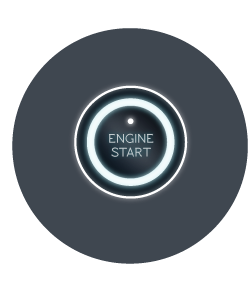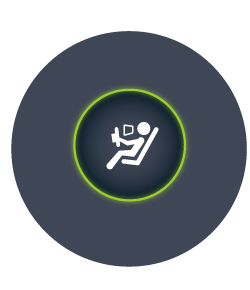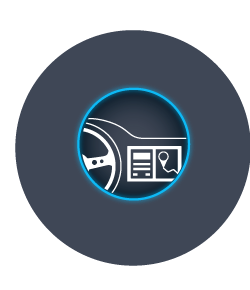Automobiles have come a long way since their beginning in the late 19th century.
One of the major things that have helped automobiles to provide more safety and convenience is electronics. With the advances in technology and electronics, car manufacturers have been able to offer a wide variety of services and conveniences.
From the creation of the Electronic Fuel Injection to the popular Global Positioning System found standard in many cars today, the auto industry has revolutionized the way people travel from place to place. Today making the potential of what the car of the future will be truly limitless. Imagine the possibilities!

Computing technology is enabling amazing experiences, enhanced productivity, better safety, and improved efficiency for businesses and consumers every day. From cars that recognize drivers, to supermarket displays that help shoppers plan dinner menus, computing devices are becoming more connected, more context-aware, and more adaptive to human needs.
These new computing experiences are possible because of a new category of embedded systems called "intelligent systems." Electronic devices that were once disconnected and served a single purpose have given way to securely managed, intelligent systems that autonomously connect to the internet, execute native or cloud-based applications, and analyze data collected.
"Technology and vehicles are integral components of everyday life and by
combining the two, we can we achieve a truly connected, mobile lifestyle"
The purpose of this project was to enable the client to obtain valuable insights into consumer experiences in vehicles. Those insights were aimed to be applied to the development of future vehicle and transportation infrastructure experiences more enjoyable, intuitive and safe.
The role in this project included conducting various forms of research including Ethnography, Technical Research, and Landscape Analysis.
"The perfect driving experience would be a car that drives itself and I didn�t have to touch it. You just put the destination of where you want to go and the car will take you there."
Participant

With this research we aim to understand all aspects of a person�s experience with the concepts we are designing.
What is the effect of adding personalities to a speech interface in the car? What are the benefits of adding a gesture pad to a steering wheel? What is the ideal driving experience? These are some of the areas that we are currently focusing on. Read on to find out what we have found out so far.
Speech interfaces that incorporate elements of social interaction may increase the user experience as compared to current systems. Humor was selected as a social interaction to explore, and designed a prototype with different scenarios adding certain humorous elements.
A low fidelity prototype was designed on a tablet to simulate an IVI (in vehicle infotainment device).

Speech interfaces that incorporate elements of social interaction may positivelyaffect the user experience. Personality, as one aspect of social interaction, was explored by developing a prototype with three distinct personalities: Neutral, Encouraging, and Snarky.
A low fidelity prototype was designed on a tablet to simulate an IVI (in vehicle infotainment device).
We wanted to know what the appropriate amount of verbosity should be in a vehicle interface. When does too much verbosity become overwhelming? Verbosity is defined as the level of information provided to the user through visual and audio outputs.
A laptop-based prototype was developed, conveying three scenarios with varying levels of verbosity.
With this project, we set out to find out what level of control people are comfortable with when interacting with their car system. Control is defined as the input the user has into the decisions that the system makes.
We developed a laptop-based prototype that conveyed a scenario with different levels of control.
How could touch-gestures be used to enhance and facilitate the access of data while driving? To answer this question we designed a prototype consisting of a touchpad embedded on a steering wheel.
To assess the gesture pad we had people interact with scene based system that simulated driving and included the gesture pad for interaction. We interviewed and observed people during these interactions that consisted of tapping to accept and swiping to the left to cancel. Overall the concept was well received but further studies in ergonomics are required.
We wanted to answer the question: does Speech and Air Gesture control provide a better user experience compared to Button Control?
In our research we designed a radio prototype that allowed participants to control it via voice, air gesture, and touch. In our research we designed a radio prototype that allowed participants to control it via voice, air gesture, and touch.
Vibrant Conversations is a way for a user to engage in interesting conversation with a nearby driver. During traffic assist, a mode in which the car is partially navigating and driving for the user,Vibrant Conversation enables a bored, frustrated, or tired user to contact another individual, see their interests, and have an engaging conversation in an otherwise painful environment.
To evaluate the concept a rapid prototype was created utilizing a tablet to simulate an IVI device and a wizard of oz approach where interactions was be simulated. The idea was appealing to people, but elements of privacy surfaced prominently prompting us that more research in that area in needed.
In looking to capitalize on the diverse experiences that happen outside the car while travelling inside it, we wanted to explore the concept of "capture and share." People captures a moment by touching the window and have the option to either share the artifact with other passengers and friends or simply store the image for future reference. Drivers and passengers alike can seamlessly snap their surroundings and pass them along to others for the spreading of collective memories.
To evaluate this concept, a prototype was created with a touch screen (as the window pane capturing images) set up in a car simulator. Results show that people expect a technology like this wouldn't be available for a few years but "want it now" to share images (in addition to audio and video, if possible) and save moments for their own personal use.
This prototype looked at how a center console can provide relevant and personalized information in a �smart� way. What if the system could predict what song to play in the morning based on your routine or automatically route you to your appointment based on your calendar? Results show that drivers wanted this extra �brain� to help them remember things and show them interesting content.
Our study showed that most people are very concerned about safety while driving. This prototype aimed to better understand needs around providing drivers alternative ways to getting �phone features� safely in the car. Participants explored a prototype of a car heads-up display (HUD), which is a projected image on a windshield. The HUD had shortcuts for music, messages, and other relevant content. Participants were able to navigate the HUD using a gesture pad on the steering wheel. Result showed that participants liked being able to look forward while driving and felt that the HUD was safer than looking at a center console.
Do you text while driving but feel bad because it�s distracting? How would you feel if you could have your messages read out loud or dismissed if you wanted to listen to them later? This prototype looked at different ways that drivers can receive important messages without touching their phones. This prototype showed incoming message notifications on a heads-up display and center console. Once drivers tapped to accept the message the system read the message out loud. Results showed that drivers preferred speech to reading text. They felt that it was safer and more convenient.
This design looked at the car-mobile transition drivers make when they exit their cars. This prototype is a phone application that creates a fluid switch from the car system to a mobile upon arrival. For example, if a driver is listening to an e-book in the car that content could seamlessly continue playing on a mobile once outside of the car. This app could also provide useful destination information such as walking directions or local business reviews. Users imaged leaving a car and viewed a mobile phone with walking directions to a restaurant for a friend�s birthday, the restaurant reviews, and a shortcut to call the friend that they were running late.






































